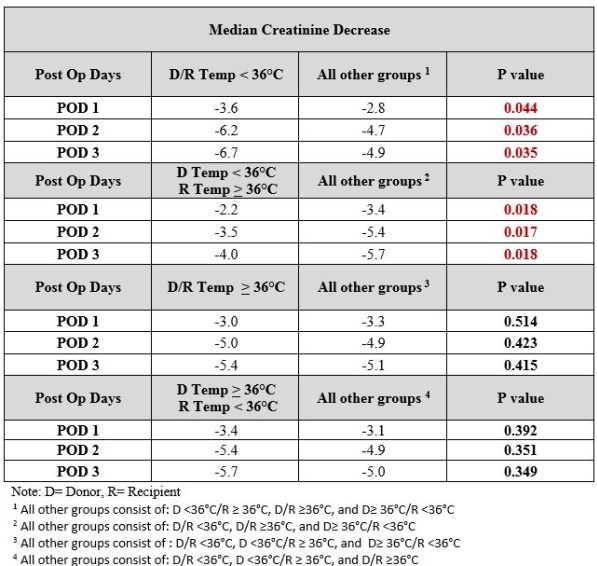Donor Hypothermia Outcomes in Living Kidney Transplantation
1Transplant Surgery, Tampa General Medical Group, Tampa General Hospital, Tampa, FL
2Molecular Pharmacology and Physiology, University of South Florida Morsani College of Medicine, Tampa, FL
3Transplant Research, Tampa General Hospital, Tampa, FL.
Meeting: 2018 American Transplant Congress
Abstract number: 221
Keywords: Kidney transplantation, Outcome
Session Information
Session Name: Concurrent Session: Kidney Living Donation: Donor and Recipient Outcomes
Session Type: Concurrent Session
Date: Monday, June 4, 2018
Session Time: 2:30pm-4:00pm
 Presentation Time: 3:06pm-3:18pm
Presentation Time: 3:06pm-3:18pm
Location: Room 6E
Background: The effect of donor hypothermia is known to significantly reduce the rate of delayed graft function (DGF) in cadaveric donor kidney transplantation. The effect of hypothermia in living kidney transplants (LKT) has not been well explored. We hypothesized donor hypothermia affects living kidney transplantation results. Methods: We conducted a retrospective cohort study from January 2014 – December 2016 on all consecutive LKTs performed at our transplant center. We examined the correlation of donor (D) and recipient (R) temperatures in LKT based upon four groupings of temperature combinations of donors (prior to cross clamp) and recipients (prior to reperfusion) with temperature ≥ 360C and or <360C . The difference in continuous variables across compared groups was assessed using the Mann-Whitney U test and were reported as a mean ± standard deviation. Binary variables were compared using chi-square test. Statistical significance was set at 5% for all comparisons. Results: We performed 117 LKT. There were 29 D/R <360C, 22 D <360C/R ≥ 360C, 38 D/R ≥360C, and 28 D≥ 360C/R <360C (N=117). Median CIT between groups was not significant. There were 4 cases of DGF (1 D/R <360C and 3 D <360C/R ≥ 360C) OR 14.84, 95% CI (1.464-150.462); P value=.02. Median post-operative (PO) creatinine improved most for D/R Temp<360C vs. other groups Day #1 (-3.6 vs. -2.8), P=.04; Day #2 (-6.2 vs. -4.7), P=.04; Day #3 (-6.7 vs. -4.9), P=.04. Decline in PO creatinine was most sluggish for D<360C/R ≥ 360C vs. all other combinations Day #1 (-2.2 vs. -3.4), P=.02; Day #2 (-3.5 vs. -5.4), P=.02; Day #3 (-4.0 vs. -5.7), P=.02. Conclusions: Donor and recipient hypothermia in living kidney transplantation correlates with less DGF and greater decline in creatinine compared with hypothermic donors and warm recipients. Further examination of hypothermia in living kidney transplantation is warranted. 
CITATION INFORMATION: Buggs J., Wei J., Rogers E., Liu R., Bowers V. Donor Hypothermia Outcomes in Living Kidney Transplantation Am J Transplant. 2017;17 (suppl 3).
To cite this abstract in AMA style:
Buggs J, Wei J, Rogers E, Liu R, Bowers V. Donor Hypothermia Outcomes in Living Kidney Transplantation [abstract]. https://atcmeetingabstracts.com/abstract/donor-hypothermia-outcomes-in-living-kidney-transplantation/. Accessed December 28, 2025.« Back to 2018 American Transplant Congress
